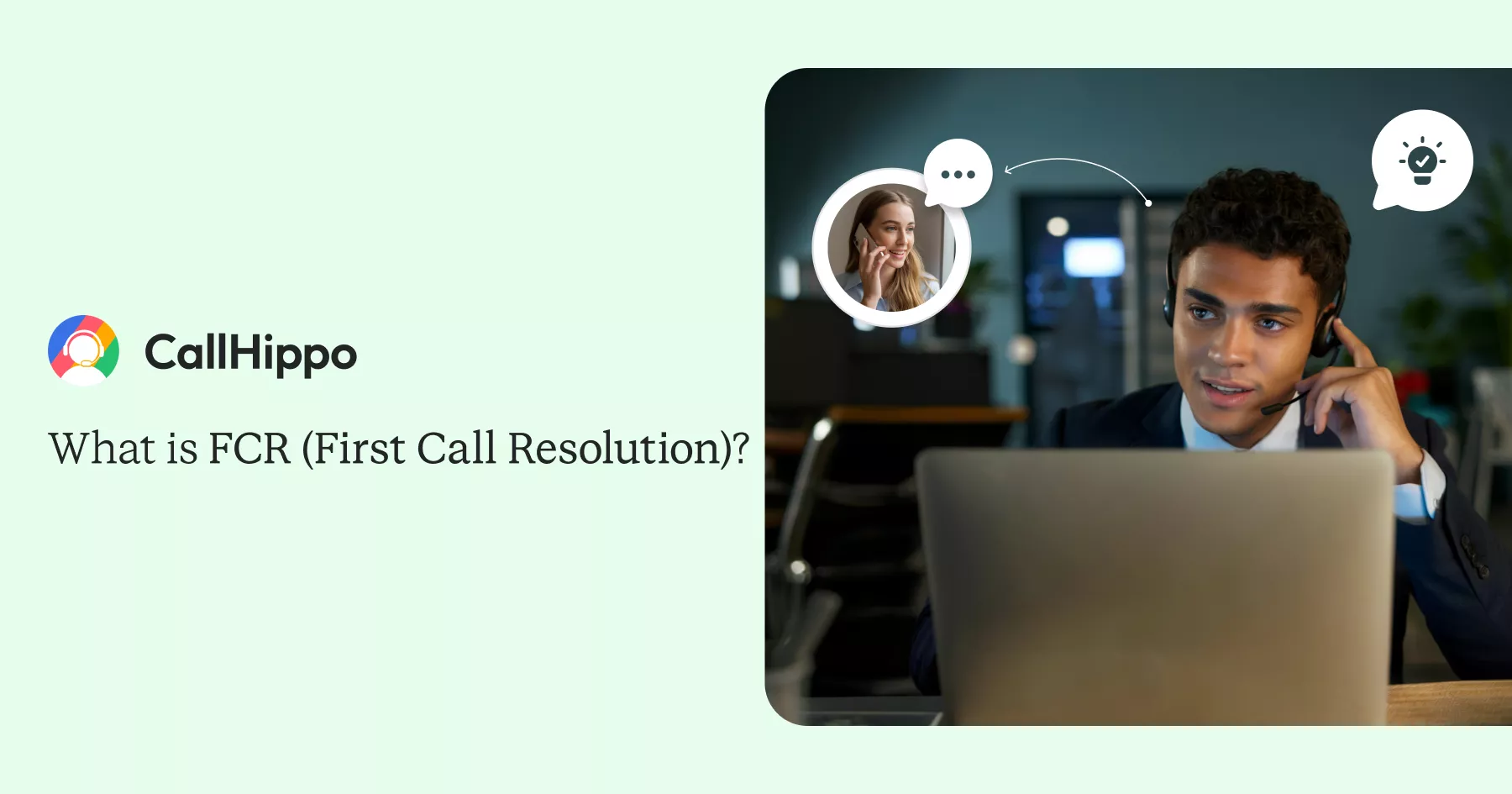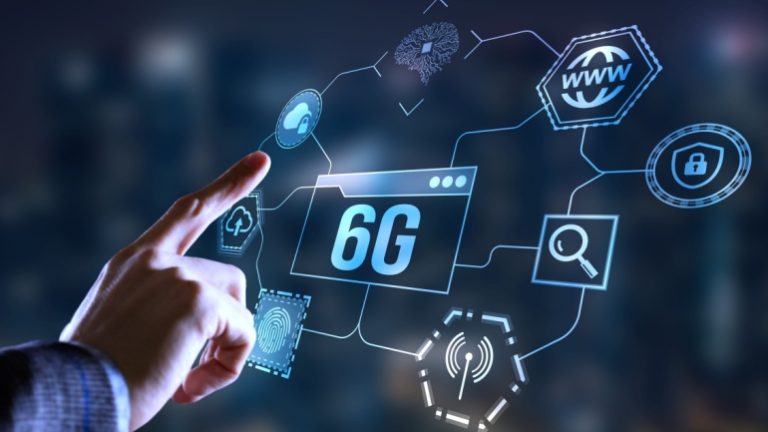

Updated : October 24, 2025
Your customer calls about a billing error. Your agent fixes it. Three days later, same customer, same error, different agent. You just paid double to solve one problem.
This happens thousands of times monthly in your contact center. Each repeat call costs you money and loses customer trust. First Call Resolution (FCR) fixes both. Resolve issues once, cut costs, and keep customers loyal.
Then where’s the issue coming from? Most businesses measure FCR but never improve it. We’ll tell you how you can improve it and much more. Let’s start with the blog.
What is FCR (First Call Resolution)?
FCR (First Call Resolution) is a metric that measures how many customer issues your team resolves during the first interaction. It is a very important metric for customer service team members and call centers as it helps measure customer satisfaction, operational costs, and efficiency.
If you have a high FCR rate, it means your support process is effective and efficient. It increases customer loyalty and reduces repeat contacts for the same issue.
Why is FCR Important For Business?
Here are some of the reasons that make first contact resolution an important metric for businesses:
1. Most Important Call Center Metric
Call centers measure many metrics. Average handle time, customer satisfaction scores, net promoter scores, abandonment rates, etc. Each metric tells part of the story. FCR tells the complete story.
When your support team’s first call resolution rate climbs by 1%, your customer satisfaction score rises by the same amount. When FCR drops, every other metric suffers. Customers get frustrated. Agents feel defeated, and costs spiral upward.
2. Lower Operational Costs
Every repeat call costs money, agent salaries, phone system expenses, technology infrastructure, and training investments. These costs compound when customers call multiple times for the same issue.
Research shows that improving your first call resolution rate by 1% cuts operational costs by 1%. For example, a contact center processing 4,000 calls monthly with a 50% FCR rate spends roughly $112,000 monthly on operations. Improving FCR to 75% saves $28,000 per month. That’s $336,000 annually just by fixing resolution processes.
3. Reduced Repeat Calls
Repeat calls create a vicious cycle.
Customers call back > Queues grow longer > Wait times increase > Agent stress rises > Service quality drops > More customers call back,
The average contact center resolves 69% of issues on the first try. That means 31% of customers must contact you again. If you handle 10,000 calls monthly, you’re dealing with 3,100 unnecessary repeat interactions. FCR breaks this pattern.
4. Better Customer Retention
Customers go to competitors for one primary reason: poor customer service experiences. When you don’t solve their problem on the first call, you communicate that their time doesn’t matter. It affects customer experience, and the retention gap is massive.
95% of customers continue doing business with companies that achieve first call resolution. That number drops to 52% when customers must make multiple contacts. In any year, 40% of customers switch to competitors specifically because first call resolution didn’t happen.
Fix FCR, and you fix retention. Customers who get a resolution on the first try stay loyal. They renew contracts, upgrade services, and become your best advocates.
How to Measure First Call Resolution?
We will look at two different ways to measure first call resolution:
1. External Method
External measurement puts the customer in control of defining resolution. The customer decides if you actually solved their problem.
A. Customer Decides
Ask customers directly. Send them a survey. Call them back. Let them tell you if their issue got resolved. This approach captures reality instead of assumptions.
The question matters. “Was your issue resolved today?” gives you accurate data. “How satisfied are you with today’s service?” measures something different. Satisfaction doesn’t equal resolution. A customer can feel satisfied with your agent’s empathy while their core problem remains unsolved.
B. Post Call Or Email Survey
Deploy surveys immediately after interactions. Wait 24-48 hours for email surveys. The timing window affects response rates and accuracy.
Ask three critical questions: Did we resolve your issue today? Would you need to contact us again about this? How likely are you to recommend us? The third question validates the first two. Customers who answer yes to resolution typically give high recommendation scores. This cross-validation reveals gaps where agents believe issues are resolved but customers disagree.
C. Benchmark Against Other Organizations
External measurement enables comparison with industry standards. Internal metrics can’t tell you if your 75% first call resolution rate is excellent or mediocre. Benchmarking provides context.
Join industry groups. Participate in benchmark studies. Compare your FCR performance against similar organizations. This competitive intelligence reveals improvement opportunities you might miss by looking only at internal data.
2. Internal Method
Internal measurement relies on your contact center software systems and criteria to determine resolution. You control the definition, you track the data, and you decide what counts as first call resolution.
A. Based On Organization Criteria
Define resolution based on your specific business needs. A cable company might consider installation appointments scheduled as resolved. A software company might require the bug fix to be verified as complete.
Create clear criteria, document them, and train every agent on the definitions. Consistency matters more than perfection. If different supervisors apply different standards, your FCR data becomes meaningless.
B. Look For a Call Back Within 30 Days
Track customer contact patterns. If someone calls about billing on Monday and calls about billing again on Tuesday, that first interaction wasn’t resolved. Most organizations use a 30-day window. Some use 7 days. Others extend to 90 days for complex issues.
The callback window changes based on your business type. Tech support might use 7 days. Insurance claims might need 45 days. Equipment installation could require 90 days. Match your measurement window to your resolution timeline.
C. Uses CRM, QA, or Repeat Call Tech
Deploy technology to track resolution automatically. Customer relationship management systems log interaction history. Quality assurance software analyzes call patterns. Repeat call technology flags when the same customer contacts you about the same issue.
Connect these systems to your customer service portal. When a customer calls, your CRM should display their complete interaction history. Your agent sees they called last week about their bill. They called yesterday about the same bill. That’s a repeat call. The first interaction failed to achieve the first contact resolution rate.
D. Supporting Metrics
First call resolution doesn’t exist in isolation. Three supporting metrics validate your FCR measurement and reveal improvement opportunities.
1. Average Handle Time (AHT)
Average handle time measures how long agents spend on each interaction. The relationship between AHT and FCR tells you if agents are rushing through calls or taking time to solve problems properly.
Low AHT with low FCR signals a problem. Agents are ending calls quickly without resolving issues. Customers call back. Your FCR suffers. Medium AHT with high FCR indicates efficiency. Agents solve problems in a reasonable time frame.
Formula: Average Handle Time (AHT)
- (Total Talk Time + Total Hold Time + Total After-Call Work Time) / Total Number of Calls Handled.
2. Customer Satisfaction Score (CSAT)
Customer satisfaction score captures how customers feel about their experience in the entire customer journey. Survey customers immediately after interactions. Ask them to rate satisfaction on a scale.
Compare CSAT scores for resolved versus unresolved issues. The gap reveals how much first call resolution drives satisfaction. Most organizations see a 20-35 point difference in CSAT between resolved and unresolved interactions.
Track CSAT alongside FCR over time. Both metrics should move together. If your first call resolution rate improves but CSAT stays flat, you’re resolving issues but creating negative experiences in the process.
Formula: Customer Satisfaction Score (CSAT)
- (Number of satisfied responses / Total number of responses) x 100
3. Net Promoter Score (NPS)
Net promoter score measures customer loyalty through one question. “How likely are you to recommend us to a friend or colleague?” Customers who experience first call resolution score 30-40 points higher on NPS than customers who need multiple contacts.
Formula: Net Promoter Score (NPS)
- % Promoters – % Detractors
What is the First Call Resolution Formula?
The basic calculation of the first contact resolution metric is that it divides total issues resolved on the first try by total customer interactions, multiplied by 100.
Formula: First Call Resolution Rate
- (Total Issues Resolved on First Try / Total Customer Interactions) × 100
For example, a contact center receives 500 calls in one day. They resolve 345 issues on the first interaction. Their first call resolution rate equals (345 ÷ 500) × 100 = 69%.
The complexity lies in defining what counts as each variable. What qualifies as “resolved on first try”? Does a call transfer count as first call resolution if the second agent solves it? What about tickets that require backend processing?
Create explicit rules. Document edge cases. Apply standards consistently. Your first call resolution formula only works when everyone measures the same way.
What is the Industry Standard for First Call Resolution Rate?
Industry standards for the first call resolution rate vary by sector and complexity. Four categories define performance levels.
1. Needs Improvement: Below 70%
Contact centers operating below 70% FCR require immediate attention. Roughly 30% or more of your customers must contact you multiple times. Operational costs run high. Customer satisfaction suffers. Agent morale declines.
2. Industry Average: 70-74%
Most contact centers cluster in this range. You’re meeting baseline expectations. You’re not standing out. This represents the minimum acceptable performance for competitive businesses in 2025.
3. Above Average: 75-79%
Organizations in this range demonstrate strong operational execution. They’ve implemented most first call resolution best practices. They track metrics consistently. They invest in agent training and technology.
4. World-Class: 80% and Higher
Only 5% of contact centers achieve world-class first call resolution rates. These organizations make FCR a strategic priority. They embed resolution into their operating philosophy. They measure, analyze, and optimize continuously.
Industry sector affects these benchmarks. The FCR rate ranges from 46% to 88% across industries. Retail averages 78% FCR due to simpler transactions. Technology support averages 65% FCR because technical issues require deeper expertise and multiple diagnostic steps.
Boost Your FCR with CallHippo!
Discover tools that help your agents resolve issues on the first call.
What are The Challenges in Achieving FCR?
Here are some challenges that businesses face in achieving FCR:
1. Complex Customer Issues
Complex issues require coordination across multiple systems and departments. A billing error might originate from a promotional discount failure that cascades through checkout, inventory, billing, and payment processing systems. Each system operates independently. Data doesn’t sync in real-time. Agents see only their department’s view of the problem.
Multi-system issues create resolution barriers. The agent handling the call lacks access to all relevant systems. They can’t verify what happened at each step. They can’t identify where the failure occurred. They must transfer the customer to specialists who own different parts of the process.
2. Lack of Agent Training
New agents complete 2-4 weeks of training covering product fundamentals, common scenarios, and system navigation. Then they handle live customer contacts that don’t match any training scenario.
Customers describe problems using different terminology. They combine multiple issues in one call. They encounter edge cases that training never covered. New agents follow scripts that don’t address the actual situation. Resolution fails.
Product updates create ongoing gaps. Companies launch features monthly, update functionality quarterly, and change pricing annually. Agents trained six months ago don’t know the last three updates. They provide outdated solutions. Customers call back.
3. Poor Communication Across Departments
Customer issues cross departmental boundaries. Your organizational structure doesn’t. A delayed order triggers calls to customer service, but they can’t access fulfillment systems. Fulfillment can’t see the customer service history. Each department asks customers to repeat their story.
Information silos damage FCR in three ways: agents lack complete context, departments implement changes without coordination, and no one owns end-to-end resolution.
Marketing launches promotions without notifying customer service about details, eligibility, or exclusions. Agents scramble for information. They provide inconsistent answers. FCR drops.
How To Improve First Call Resolution?
Here are some of the measures you can take to improve the first call resolution rate:
1. Agent Training and Empowerment
Training needs to extend beyond product knowledge. Agents need diagnostic skills. They need to ask probing questions. They need to recognize patterns across different problem descriptions.
Create scenario-based training that mirrors real interactions. Don’t teach agents about billing policies in abstract terms. Give them five examples of actual billing complaints. Walk through the diagnostic process. Show them how experienced agents identify the root cause.
2. Customer Quality Assurance
Traditional quality assurance monitors compliance. Did the agent follow the script? Did they offer the required upsell? Did they complete the security verification? This approach misses the critical question. Did they resolve the customer’s issue?
Customer quality assurance flips the model. Evaluate agents based on customer outcomes instead of process compliance. Survey customers after interactions. Did the agent resolve your issue? Track callbacks. Did this customer contact you again about the same problem?
3. Monitoring And Feedback
Monitoring identifies problems. Feedback drives solutions. Most organizations monitor constantly and provide feedback quarterly. That delay destroys improvement opportunities. Create daily feedback loops. Agents should see their first call resolution rate every day. They should know which interaction types they handle well. They should understand where they struggle.
Aggregate data reveals patterns. Five agents all have low FCR for password reset issues. The problem isn’t the agents; the problem is your password reset process. Fix the process. The agents’ performance improves automatically.
Real-time monitoring enables in-call coaching. A supervisor notices an agent struggling with a complex issue. The supervisor can whisper guidance
4. AI-driven Support For Faster Answers
Agents can’t remember every product detail. They can’t recall every policy exception. They shouldn’t need to. AI tools surface the right information at the right moment.
A customer calls about a warranty claim. The AI system listens to the conversation. It identifies key details. It searches the knowledge base. It presents the agent with the relevant warranty policy and the claim submission process. The agent has the answer in seconds instead of minutes.
AI handles the search work. Agents focus on the customer. The interaction flows naturally. Resolution happens faster. First call resolution rates improve because agents aren’t guessing or putting customers on hold to search for information.
5. Use Intelligent Call Routing To Connect The Customer To The Best Agent
Random call distribution doesn’t work. The next available agent gets the next call regardless of expertise. A new agent receives a complex technical issue. They struggle. They transfer. They escalate. First call resolution fails.
Intelligent call routing analyzes the customer’s need before assignment. A customer calls about billing. The system reviews their history. They’ve called three times about the same billing issue. This requires a senior billing specialist, not a new agent.
Skills-based routing matches customer needs with agent expertise. Your team includes generalists and specialists. Simple issues go to generalists. Complex issues route to specialists. Each agent handles calls within their capability range.
Emerging Trends in First Call Resolution
Here are some of the emerging trends in first call resolution:
1. Omnichannel Support Integration
Customers think in conversations, not channels. They start on your website, move to chat, then call when chat fails. Each channel operates independently. They repeat their story three times.
Omnichannel integration maintains context across channels and improves resolution rates. When agents see complete customer journey timelines, whether the customer emailed, tweeted, or chatted before calling, they resolve issues faster.
2. Real-Time Performance Dashboards for Agents
Most agents don’t see their performance until monthly reviews. They take calls blind. They don’t know if they’re improving or declining.
Real-time dashboards show agents their current FCR, daily callback counts, and team averages. The visibility creates motivation. Add points for high FCR and rewards for consistency. Competition drives engagement, and engagement improves performance.
When agents see their FCR daily with trend lines, they adjust their approach. Reward improvements, agents who raise FCR by 5% earn recognition or benefits.
Take Action Today!
Pick your three highest-volume call types. Pull the first call resolution rate for each. Identify the one with the lowest FCR. Listen to five recordings of those calls. Find the common failure point. Fix that one thing this week.
FAQs
1. What if the customer says “resolved,” but later calls back?
Trust the callback data over the survey response. Some customers say an issue is resolved to end an uncomfortable interaction. Others believe it’s resolved until they try to use the solution and discover it doesn’t work. Track both metrics.
2. Does a transferred call count as first-call resolution?
Define this in your measurement criteria. Most organizations say no. A transfer means the first agent couldn’t resolve the issue. The customer made one call but had multiple interactions. Some organizations count soft transfers as FCR. Soft transfers happen when the first agent stays on the line, introduces the specialist, and ensures resolution before disconnecting.
3. Is aiming for 100 % FCR realistic?
No. Some issues legitimately require multiple interactions. A complex insurance claim might need documents that the customer doesn’t have immediately.
4. How often should I review FCR performance?
Monitor daily. Analyze weekly. Act monthly. Daily monitoring catches sudden drops that indicate system problems or process failures. Weekly analysis reveals trends and patterns. Monthly reviews enable strategic decisions about training, technology, and process changes. Quarterly reviews should include benchmark comparisons against industry standards.
Published : October 24, 2025


Priya Naha is an experienced technical content writer who focuses on VoIP and telephony technologies. Her expertise in telecommunication and content marketing allows her to simplify complex topics with real-world knowledge, making her writing relatable, informative, and easy-to-read. Her direct involvement with VoIP products and solutions makes her a reliable voice in the field.


Let’s Stay in Touch
Subscribe to our newsletter & never miss our latest news and promotions.
![]()
![]() +24K people have already subscribed
+24K people have already subscribed
Source



